

Simparica Trio provides triple protection against fleas and ticks, intestinal worms and deadly heartworm disease all in a tasty monthly chew. Si...
View full detailsFleas are a problem because they cause irritation and disease. They bite your dog to feed on blood and this happens so fast that partially digested blood (flea dirt) can be seen in minutes. Female fleas feed often and can consume up to ten times their weight in just 24 hours. Multiply that by 30 fleas and you'll get a really sad pet. Here at Kellyville Pets we have you covered for flea control for dogs at the cheapest prices delivered Australia wide. Read our reviews on dog flea treatments.
Flea Allergy Dermatitis (FAD) is the most common skin disease of dogs and cats, caused by irritation from flea bites.
Signs of FAD include:
Fleas can also transmit diseases to your pet and your family. Your pet can catch the flea tapeworm from infected fleas and pass it on to other pets and humans. Cat-scratch disease is also transmitted by infected fleas and causes a skin infection in humans. So, for the comfort and safety of your dog, look for a treatment that stops fleas fast
The secret life of fleas Adult Fleas - only the tip of the iceberg
Despite being the most recognisable, adult fleas account for the smallest number of the flea population present during an infestation on your dog. They emerge from a cocoon when conditions are just right. To survive, they must feed immediately. Adult fleas feed and mate within 24 hours and lay eggs 36-48 hours after that, therefore fast killing is crucial.
Flea control for dogs is easier if you prevent fleas on your dogs.
Regular cleaning of your dog's favourite areas including bedding and carpet will also help to eliminate further flea eggs and larvae.
When choosing a dog flea treatment, there are many different types of products available including dog flea products that not only treats fleas on your dog, but also treats other flea stages and your dog's surroundings.
To reduce irritation and discomfort from flea bites, choose a flea treatment that kills fleas on contact and doesn't rely on fleas biting to take effect. The types of dog flea treatment for puppies and dogs available include Advantage for dogs, Advantix for dogs, Advocate for dogs, Capstar for dogs, Comfortis for dogs, Frontline for dogs, Nexgard for dogs and Revolution for dogs.
Dog flea treatments can be categorised into 2 main parts:
Flea products to rid fleas on your dog Spot on treatments - very effective, easy to apply, once a month treatments. Some products include worming or heartworm treatment as well as flea treatment.
Examples of spot on treatments include Advantage, Advantix, Advocate and Revolution.
Dog Flea shampoo - kills fleas on your pet at the time of the bath, but once rinsed off have no lasting effect on fleas.
Rinses and sprays - vary in effectiveness, some need to be used weekly, some more often if severe flea problems are present. Rinses must be applied to a clean, mostly dry coat at the correct concentration to be effective.
Tablets like Capstar flea tablets will kill fleas fast within 30 minutes offering immediate relief from fleas but not treat the environment.
Collars & Powders - are helpful, but not the most effective treatment Flea control for the environment Dog flea control strategies including - Vacuum the carpet 2-3 times a week to remove eggs and stimulate dormant fleas, wash pet blankets weekly (in the washing machine) and leave in the sun to dry, spray the house, kennels and yards with an adult flea killer (professional treatment recommended) fog the house with a flea bomb to prevent larvae developing.
There are many different types of intestinal worms that your dog can get
- dogs can have the following intestinal worms-
roundworms, hookworms, tapeworms, and whipworms.
There are lots of symptoms for dogs that have intestinal worms. Dogs coughing is one of the signs a dog has worms. Dogs may develop a cough if they have hookworms and roundworm. Dog may vomit if they have Roundworms. Soft stools and canine diarrhoea can be the result of worms. Dogs with hookworms may have blood in their faece. Dogs with intestinal dog worms that are lethargic and less active than normal may be showing symptoms of having worms.
Potbellied appearance is commonly seen in puppies that have picked up worms from their mother dog .
If your dog starts to appear potbellied or bloated, it may have contracted intestinal worms.
Your dog may have intestinal worms if you notice a sudden change in your dog’s appetite, your dog may have intestinal roundworms if the dogs appetite has changed. Dogs that are infected often lose their appetite. As intestinal worms steal a dog’s nutrients, a dog with gut worms may also show a sudden increase in hunger as a result of intestinal dog worms. Your dog could have tapeworm if your dog shows signs of rapid weight loss, he may have a tapeworm or your dog may have a whipworm.
If your dog’s coat begins to dull or if your dog’s coat dries out your dog may have picked up a form of worms a healthy dog should have a shiny thick coat as a healthy dog does not have worms. Loss of hair or the appearance of rashes can also be a symptom of worms. A dog could have a severe worm problem if the dog show signs of skin irritation it may have a severe infestation of worms.
Dogs with intestinal worms will occasionally rub their rear ends on the floor in order to relieve themselves of the itch due to worms in their bottom and they will rub their bottom on the ground. Roundworms can often be seen in a dog’s faeces. Tapeworms may appear as small moving segments in the fur or area around dog’s anus if the dog is infested with tapeworm.
A Paralysis tick it a small tick that feeds on the blood of animals a bush tick feeds on animal’s blood also. When a paralysis tick is feeding on the blood of animals it secretes a toxin into the animal’s blood which is potentially lethal with the administering of the toxin from the paralysis tick. Bush ticks also administer a toxin that is not as harmful as the paralysis tick. The paralysis tick is far more dangerous than the bush tick. A paralysis tick’s toxin can cause paralysis in a dog and even death in dogs from the paralysis tick..
On the eastern coast of Australia Paralysis ticks are very commonly found on the coast in warm weather, bush ticks are found near water or dog ticks can be found near dense bushland. Paralysis ticks are found year round but the population increases in the warmer weather like the start of summer. Bush ticks can be found year round near bushland. Bush ticks can be found year round and in any long grass or bushland the dog ticks can be found.
Products to prevent ticks on dogs available at Kellyville pets include- Advantix, Kiltix collars, Nexguard and Frontline plus


Simparica Trio provides triple protection against fleas and ticks, intestinal worms and deadly heartworm disease all in a tasty monthly chew. Si...
View full details

Simparica is a great tasting chewable tablet given orally once a month that prevents and kills fleas and ticks within hours. It travels in your do...
View full details

Multi spectrum intestinal wormers for puppies and adult dogs. For the control of ROUNDWORMS - Toxocara canis, Toxascaris leonina WHIPWORMS - Tr...
View full details

Nexgard Spectra for Dogs Nexgard Spectra is a once a month, chewable tablet for the effective control of fleas, ticks, heartworm and intestinal wo...
View full details

Advocate for Dogs provides comprehensive protection from fleas, heartworm, roundworms, hookworms, whipworm, oesophageal worm, mites and lice. An ea...
View full details

Long-lasting protection from dangerous paralysis ticks and frustrating fleas Just one tasty chew defends your dog from paralysis ticks for 4 month...
View full details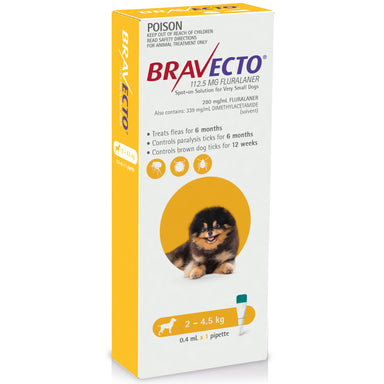

Rest easier with 6 months protection from fleas and paralysis ticks in one Spot-onTreatment and control of ear mites Also treats and control sarco...
View full details
Drontal Worming Suspension is recommended for the control of gastrointestinal worms in puppies and small dogs including Roundworm, Hookworm, Whipwo...
View full details
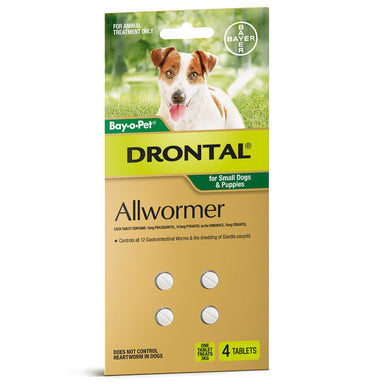
Gentle, effective control of all 11 gastrointestinal worms Roundworm, hookworm, whipworm, tapeworm (including hydatid) Does not control heartworm i...
View full details

Do you ever wonder if there was one magic chewable dog worming tablet that could do it all? One chewable dog worming tablet to rule them all? One c...
View full details

Trusted by Australian vets for over 20 years, Milbemax delivers broad-spectrum protection for dogs against common intestinal worms, including round...
View full details

Advantix for Dogs is a fast-acting, once a month topical flea, tick and biting insect treatment for your dog. Apply fortnightly for paralysis ticks...
View full details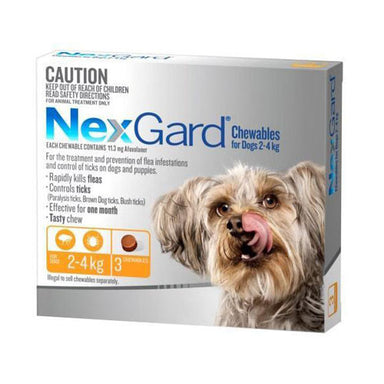

NexGard for dogs kills adult fleas before they lay eggs, and kills ticks, too. All in a delicious, soft chew that dogs love.NexGard is for use in d...
View full details

The Seresto™ collar is the longest lasting flea and paralysis tick protection for dogs and puppies, providing consistent protection for 8 months. S...
View full details
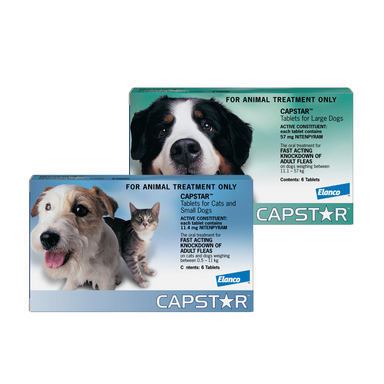
Capstar is a fast acting tablet that starts killing fleas within just 30 minutes! Capstar offers rapid and effective relief from fleas and should b...
View full details
Frontline Spray controls fleas and ticks, and can be used on puppies and kittens from 2 days of age. Frontline Flea and Tick Spray for Cats and Dog...
View full details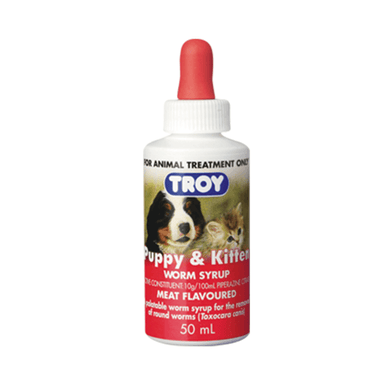
Troy Puppy and Kitten Worming Syrup will help you protect young puppies and kittens against round worms. Containing the active ingredient piperazin...
View full details
Revolution for Puppies and Kittens provides essential vet-grade protection against fleas, heartworm and other nasties.Revolution contains selamecti...
View full details

Simparica Trio provides triple protection against fleas and ticks, intestinal worms and deadly heartworm disease all in a tasty monthly chew. Si...
View full details
